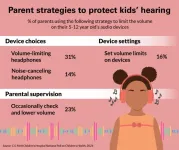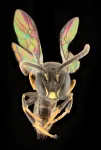(Press-News.org) BOSTON – About eight million people live with Type 1 diabetes (T1D) worldwide, a chronic autoimmune condition in which the body attacks and destroys its own insulin-producing β-cells (pronounced “beta”) in the pancreas, leading to a lack of insulin and inability to regulate blood sugar. It’s not known why the body suddenly perceives its own β-cells as the enemy; some lines of evidence suggest environmental factors such as viral infections may trigger the onset of T1D, others suggest genetics may also play some role.
Groundbreaking research by investigators at Joslin Diabetes Center sheds new light on the specific changes β-cells go through at the onset of T1D. Their findings—published in Nature Cell Biology—offer new avenues for targeted interventions for the chronic autoimmune condition.
“In the field of Type 1 diabetes, research has largely focused on understanding the immune component, but our study argues that the β-cell is a significant player,” said Rohit N. Kulkarni, M.D., Ph.D., Margaret A. Congleton Chair and Co-Head of the Section on Islet & Regenerative Biology at Joslin Diabetes Center. “Our findings suggest that the β-cell could be initiating key events which then promote the autoimmune mechanism to go awry. It's a paradigm shifting approach.”
In a series of experiments with β-cells taken from a mouse model of T1D, as well as from humans with established T1D, Kulkarni and colleagues teased out the complex cascade of biochemical steps called a signaling pathway that controls the innate immune response at the onset of T1D. The team identified one pathway that influences the immune characteristics of β-cells, acting like control switches that identify them as friend or foe to the body. These control switches can be imagined as tiny tags. One specific tag the investigators focused on—called N6-methyladenosine (m6A)—plays a vital role in the response of β-cells during T1D onset. By adjusting these control switches, the researchers were able to influence the levels of a crucial protein along this pathway, leading to a notable delay in the progression of the disease in a mouse model of T1D.
Dario F. De Jesus MSc, Ph.D., lead author of the study and Research Associate in the Kulkarni Lab, identified the key enzyme METTL3 as crucial for regulating β-cell antiviral defenses. In the late stages of T1D, when METTL3 levels were low, it hinted that higher METTL3 levels shield β-cells from dysfunction. By enhancing METTL3 production in the mouse model, the team successfully delayed progression of disease.
“This discovery suggests that interventions to boost METTL3 levels is a potential strategy to protect β-cells and slow down progression of Type 1 diabetes,” emphasized De Jesus, who is also an Instructor in Medicine at Harvard Medical School.
Taken together, these several lines of evidence paint a clearer picture of the immune events surrounding the still mysterious onset of T1D, including a novel mechanism that could be harnessed for β-cell protection. They also demonstrated that the enzyme METTL3 has the potential to promote β-cell survival and function during disease progression.
“It is notable that this pathway has commercially available compounds that have been used in the context of other diseases,” said Kulkarni, who is also a professor of medicine at Harvard Medical School. “While it's a different target, it's an approach which has been shown to work. Among our next steps, we will focus on identifying specific molecules and pathways that can be harnessed to enhance protection of the β-cell.”
Co-authors included Natalie K. Brown, Ling Xiao, Jiang Hu, Garrett Fogarty, Sevim Kahraman and Giorgio Basile of Joslin Diabetes Center; Zijie Zhang, Jiangbo Wei and Chuan He of the University of Chicago; Xiaolu Li, Wei-Jun Qian and Matthew J. Gaffrey of Pacific Northwest National Laboratory; Tariq M. Rana of University of California, San Diego; Clayton Mathews and Mark A. Atkinson of the University of Florida College of Medicine; Alvin C. Powers of the Vanderbilt University Medical Center; Audrey V. Parent of University of California, San Francisco; Sirano Dhe-Paganon of Harvard Medical School; and Decio L. Eizirik of Université Libre de Bruxelles.
This work is supported by the National Institutes of Health (grants R01 DK67536, UC4 DK116278, RM1 HG008935, and R01 DK122160). Portions of the mass spectrometry work were performed in the Environmental Molecular Sciences Laboratory, Pacific Northwest National Laboratory, a national scientific user facility sponsored by the Department of Energy under Contract DE AC05-76RL0 1830. R.N.K. acknowledges support from the Margaret A. Congleton Endowed Chair and C.H. is a Howard Hughes Medical Institute Investigator. DFDJ acknowledges support from Mary K Iacocca Junior Postdoctoral Fellowship, American Diabetes Association (grant #7-21-PDF-140, and NIH K99 DK135927).
About Joslin Diabetes Center
Joslin Diabetes Center is world-renowned for its deep expertise in diabetes treatment and research. Joslin is dedicated to finding a cure for diabetes and ensuring that people with diabetes live long, healthy lives. We develop and disseminate innovative patient therapies and scientific discoveries throughout the world. Joslin is an affiliate of Harvard Medical School, and it is one of only 17 NIH-designated Diabetes Research Centers in the United States.
Joslin Diabetes Center is a part of Beth Israel Lahey Health, a health care system that brings together academic medical centers and teaching hospitals, community and specialty hospitals, more than 4,800 physicians and 38,000 employees in a shared mission to expand access to great care and advance the science and practice of medicine through groundbreaking research and education.
# # #
END
She studies the giant explosions of dying stars and dreams of experiencing and extracting data from a supernova close to Earth. Professor Irene Tamborra from the Niels Bohr Institute also tirelessly promotes equity and inclusion in research. Today she receives the prestigious Elite Research Prize and DKK 1.2 million in honor of her research in astrophysics.
"I am fascinated by anything that explodes in the sky," Professor Irene Tamborra says as she begins to describe her research. The professor from the University of Copenhagen’s ...
In an early phase clinical trial, a combination of antibody-based medications targeting the immune system generated promising safety data and anti-tumor activity in individuals with various types of advanced cancer. The findings are published by Wiley online in CANCER, a peer-reviewed journal of the American Cancer Society.
Both medications tested in the trial support immune responses against tumor cells. CS1002 increases the activation and proliferation of T immune cells by binding to a T cell receptor called CTLA-4. CS1003, also called nofazinlimab, ...
Eight new Pacific bee species and new insights into Fijian bird behaviour on Viti Levu Island have been described in new scientific studies led by Flinders University.
The studies, both funded by field work supported by the Australian Government’s New Colombo Mobility Plan Program, highlight the potential for species discovery, ecological and conservation knowledge and cultural engagement from Asia-Pacific research collaborations.
In the past 10 years, Australian Government-funded Flinders University field trips have worked closely ...
ANN ARBOR, Mich. – While it’s not surprising to spot teens wearing headphones and earbuds, it’s also becoming a widespread trend among younger children, a national poll suggests.
Two in three parents say their child ages 5-12 uses personal audio devices, with half of parents of children ages 5-8 reporting elementary-aged kids use a device.
Among parents whose children use headphones and earbuds, half say kids spend at least an hour a day using them while one in six say a typical ...
In 1934, American entomologist Elwood Zimmerman, then an undergraduate student at Berkeley, participated in the ‘Mangarevan expedition’ to Polynesia. Among the samples he collected were three tiny (4 mm long), orange-brown solitary bees found on tahetahe flowers in the Tuamotu Archipelago.
The specimens rested undisturbed in the Bernice P Bishop Museum of Honolulu until 1965, when the famous bee specialist Prof Charles Michener examined them. He described them as a species new to science: Hylaeus tuamotuensis, or Tuamotu’s masked bee, in the family ...
Many older adults receiving home care do not receive any palliative home care before death, suggesting we need better methods to identify people who need this support, according to new research in CMAJ (Canadian Medical Association Journal) https://www.cmaj.ca/lookup/doi/10.1503/cmaj.221513.
"Palliative care is an essential component of a holistic, comprehensive and patient-centred approach to care for all people with a life-limiting illness from the time of diagnosis with the disease," said Dr. Amy Hsu, investigator at the Bruyère Research Institute and faculty in the Department of Family Medicine at the ...
Forests have a critical role to play in capturing and storing carbon from the Earth’s atmosphere – but some models exaggerate their carbon removal potential by almost three-fold, according to a leading professor of forest economics.
Global Forest Carbon: Policy, Economics and Finance by Runsheng Yin from Michigan State University emphasizes the value of nature-based solutions to the climate crisis but calls for significant changes to the way carbon credits from reforestation, afforestation, and improved forest management are calculated. He has found that current modeling of local ...
Antidepressant dispensing to adolescents and young adults increased sharply after the COVID-19 pandemic began – particularly among females – a new study finds.
While a growing number of young people ages 12 to 25 were receiving antidepressants before the pandemic, the antidepressant dispensing rate rose nearly 64% faster after March 2020, according to Michigan Medicine led findings in Pediatrics.
“Antidepressant dispensing to adolescents and young adults was already high and rising before ...
Philadelphia, February 26, 2024 – A passionate plea for the re-establishment of Canada's health coalition focused on hypertension prevention and control appears as an editorial in the Canadian Journal of Cardiology, published by Elsevier. "We need a national hypertension control program to prevent death and disability," according to prominent healthcare leaders.
Lead author of the editorial Norm R.C. Campbell, MD, Department of Medicine, University of Calgary, explains, "Hypertension is a leading cause of death and disability in Canada; globally it causes about one in five deaths (19.2%). However, ...
A drug can make life safer for children with food allergies by preventing dangerous allergic responses to small quantities of allergy-triggering foods, according to a new study led by scientists at the Stanford School of Medicine.
The research will be published Feb. 25 in the New England Journal of Medicine. The findings suggest that regular use of the drug, omalizumab, could protect people from severe allergic responses, such as difficulty breathing, if they accidentally eat a small amount of a food they are allergic to.
“I’m excited that we have a promising ...



